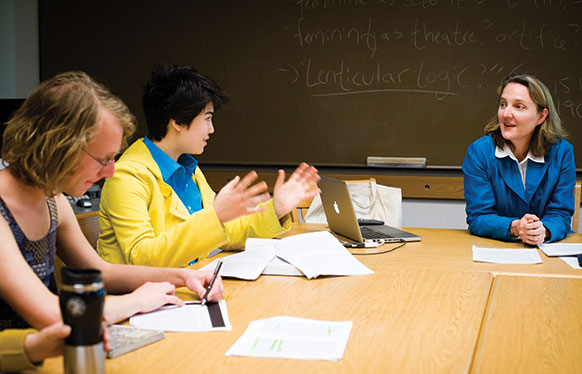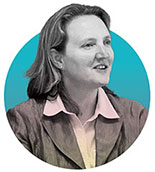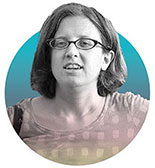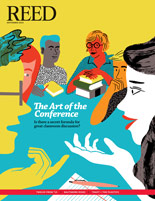
IRIS login | Reed College home Volume 94, No. 3: September 2015
The Art of the Conference (continued)

Photo by Leah Nash
The Dangerous Journey
By Prof. Charlene Makley [anthropology 2000–]

In my way of thinking, the ideal conference at Reed, like the intellectual journey of anthropology in general, is dangerous. But not just to those who might feel shy or marginalized in such communal encounters. For if we acknowledge that Reed conferences, regardless of subject matter, are high-stakes performances in which students and professors’ intellectual selves are on display, we have to move beyond the theatrics of what I call the “brains-on-sticks” model of conference dynamics to create a space in which all participants can be open to the unexpected.
If we are to realize the promise of the liberal arts education that a Reed conference supposedly embodies, we have to ask ourselves what does it really mean to share time? The anthropologist Johannes Fabian famously differentiated the state of shared (or “coeval”) time from mere simultaneous presence on the one hand (e.g., occupying a classroom between 10 a.m. and noon), and on the other, from simple contemporaneous existence (e.g., presuming we all inhabit a particular era, like we are all students, enjoying the liminal period of a college education). Such notions of unproblematic copresence, I would say, allow us to presume an easy sameness of personhood and motives, the liberal pretensions of simple dialogue and multicultural tolerance. By contrast, shared or coeval time is a joint achievement, in which participants work hard to create the conditions for co-constructed knowledge despite (and because of) our many differences. In my 15 years of teaching anthropology and Chinese studies at Reed, the best conferences I have had were multivoiced conversations in which we trusted each other enough to pose real risks to the presumptions, as well as to the personas we had brought to the room. This is not the danger of soul-crushing intellectual conquest, but, just as in anthropological research, the challenge of holistic intellectual experimentation, the courage to open one’s self to others and to other worlds.
In the ideal Reed conference, the subject matter is less relevant than this delicate work of creating the grounds for the unexpected, of opening the floor to all. In my wide-ranging anthropology courses, the best semesters we have had were when I did not over-structure students’ encounters with the materials, but instead when I worked in the first weeks especially to facilitate their encounters with each other, ceding some of my leadership to them so that we shared responsibility for our sustained conversations.
When students begin to address each other by name and respond to something new offered by another, I know we have begun to share time. When a shy or minority-identified student feels supported enough to break silence and share a thought, I can tell we have successfully created the conditions for knowledge. When the fear of error or political correctness fades and students allow each other to test ideas out loud, I realize we have constructed the grounds for mutual respect and trust. It is only then, I find, that conferences become truly dynamic, even kinetic, as we break from tables and move around the room, using the board, changing up groups, altering the space. Achieving such shared intellectual time can be fun, but also frightening. If we can only encounter the unexpected by opening to the other, by allowing our interlocutors a glimpse of our selves as works in progress, than that is the true challenge, the productive danger, of an ideal Reed conference.
![]()
Plan for the Unexpected
By Prof. Margot Minardi [history 2007–]

For me, teaching means having a Plan A, a Plan B, and a willingness to abandon both if something more interesting or important happens. The mystique around Reed’s conference model is that intellectual conversations unfold organically the moment everyone comes into the room. When that happens, it is indeed magical. But magic is unreliable, especially when it’s ten weeks into the semester and you haven’t seen the sun in 21 days.
I apply to conference teaching and learning what Max Weber said of social science research: “Ideas come when we do not expect them, and not when we are brooding and searching at our desks. Yet ideas would certainly not come to mind had we not brooded at our desks and searched for answers with passionate devotion.”
The preparation I do before class is the “brooding and searching” that will (with any luck) spark greater insight and wonder when we are all together in the classroom. What questions will cut to the core of a Supreme Court opinion or a narrative about a shoemaker’s role in the American Revolution? Is there an image from antislavery propaganda or a passage from an 18th-century novel that might offer a provocative entry point? Would a map, a timeline, or a brief discussion of the scholarly literature provide useful context? How might I encourage students to think about what’s at stake (intellectually, politically, morally) in the history of racial categorization or the framing of the Constitution? How might I arrange the students and even the furniture to promote different kinds of interactions? What would happen if students sat face-to-face in small clusters of four, rather than around a gigantic table?
On a good day, I come into class with a sense of how I want to approach each of these aspects of the class, and I have a back-up plan if my initial inclinations don’t work (that’s the “Plan B”). Some days we end up doing none of the things that I had planned, and we still have a great conference. Preparation doesn’t mean sticking to a script.
Planning and preparing are those “ingredients” that I try to bring to the table as a teacher. But in a conference that goes well, the students have done those very same things—they’ve not only finished reading Harriet Jacobs’s autobiography, Incidents in the Life of a Slave Girl, but they’ve contemplated how it compares to another classic slave narrative we’ve just read by Frederick Douglass. That way, the conference benefits from all of our separate “brooding and searching,” and we move closer in the short time we are together toward fulfilling and furthering the curiosity that brought us there in the first place.
Find out more about the Center for Teaching at Learning
- Previous Page
- 1
- 2
- 3
- 4
- Next Page

LATEST COMMENTS
steve-jobs-1976 I knew Steve Jobs when he was on the second floor of Quincy. (Fall...
Utnapishtim - 2 weeks ago
Prof. Mason Drukman [political science 1964–70] This is gold, pure gold. God bless, Prof. Drukman.
puredog - 1 month ago
virginia-davis-1965 Such a good friend & compatriot in the day of Satyricon...
czarchasm - 4 months ago
John Peara Baba 1990 John died of a broken heart from losing his mom and then his...
kodachrome - 7 months ago
Carol Sawyer 1962 Who wrote this obit? I'm writing something about Carol Sawyer...
MsLaurie Pepper - 8 months ago
William W. Wissman MAT 1969 ...and THREE sisters. Sabra, the oldest, Mary, the middle, and...
riclf - 10 months ago